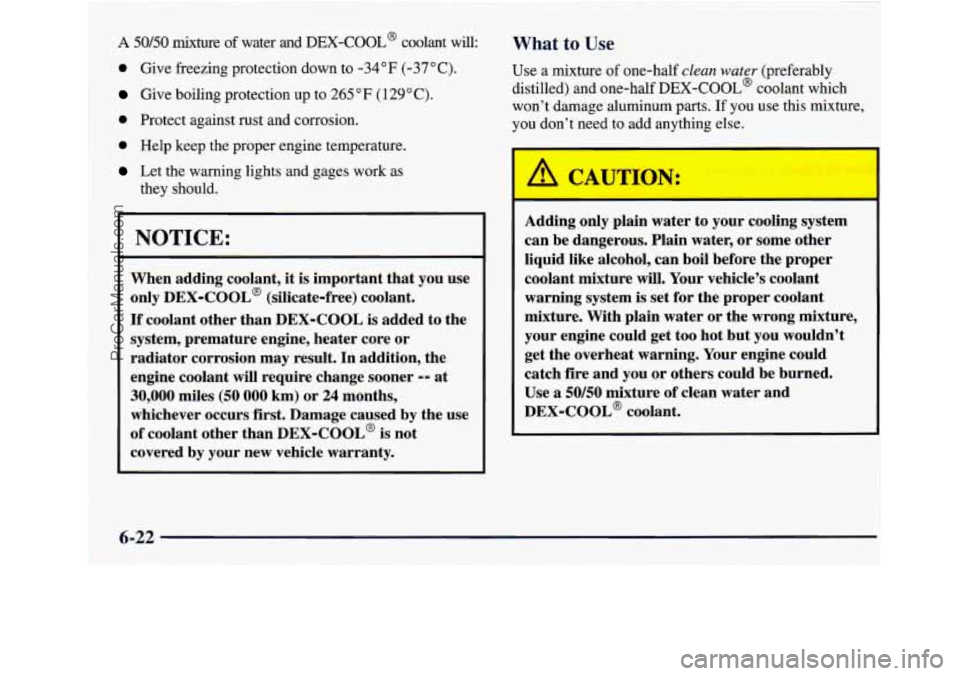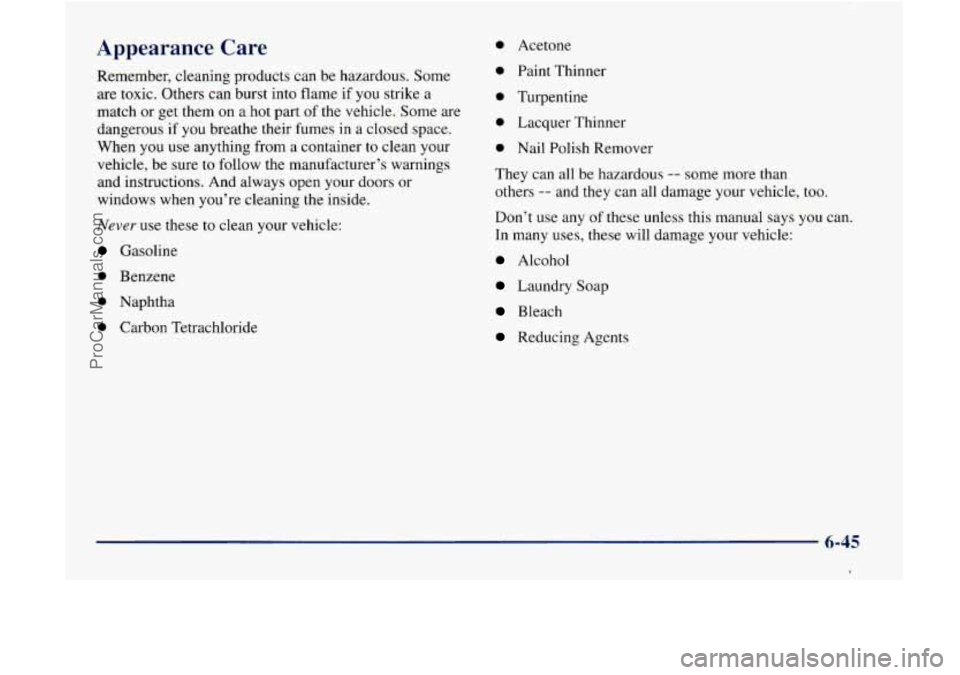1998 GMC ENVOY warning
[x] Cancel search: warningPage 261 of 386

Remote Oil Filter
The access door for the remote oil filter is in the steering
linkage shield assembly located under the radiator
support. Twist the screw to unlock or lock the door.
If
you open the door, make sure it is securely closed when
you are finished.
What to Do with Used Oil
Did you know that used engine oil contains certain
elements
that may be unhealthy for your skin and could
even cause cancer? Don’t let used oil stay on your skin
for very long. Clean your skin and nails with soap and
water, or
a good hand cleaner. Wash or properly throw
away clothing or rags containing used engine oil. (See
the manufacturer’s warnings about the use and disposal
of oil products.)
Used oil can be a real threat to the environment. If you
change your own oil, be sure to drain all free-flowing oil
from the filter before disposal. Don’t ever dispose of oil
by putting
it in the trash, pouring it on the ground, into
sewers, or into streams or bodies
of water. Instead,
recycle it by taking it to
a place that collects used oil. If
you have a problem properly disposing of your used oil,
ask your dealer, a service station or a local recycling
center for help.
To remove the air cleaner, remove the wing nuts that
hold the cover on. Remove the cover and lift
out the
air filter.
Insert
a new air filter, then replace the air cleaner cover.
Tighten the wing nuts
to hold the cover in place.
6-14
ProCarManuals.com
Page 269 of 386

A 50/50 mixture of water and DEX-COOL@ coolant will:
0 Give freezing protection down to -34°F (-37°C).
Give boiling protection up to 265 “F ( 129°C).
0 Protect against rust and corrosion.
0 Help keep the proper engine temperature.
Let the warning lights and gages work as
they should.
NOTICE:
When adding coolant, it is important that you use
only
DEX-COOL@ (silicate-free) coolant.
If coolant other than DEX-COOL is added to the
system, premature engine, heater core or
radiator corrosion may result. In addition, the
engine coolant will require change sooner
0- at
30,000 miles (50 000 km) or 24 months,
whichever occurs
first. Damage caused by the use
of coolant other than DEX-COOL@ is not
covered by your new vehicle warranty.
What to Use
Use a mixture of one-half clean water (preferably
distilled) and one-half
DEX-COOL@ coolant which
won’t damage aluminum
parts. If you use this mixture,
you don’t need to add anything else.
Adding only plain water to your cooling system
can be dangerous. Plain water, or some other
liquid like alcohol, can boil before the proper
coolant mixture will. Your vehicle’s coolant
warning system is set for the proper coolant
mixture. With plain water or the wrong mixture,
your engine could get too hot but you wouldn’t
get the overheat warning. Your engine could
catch fire and you or others could be burned.
Use
a 50/50 mixture of clean water and
DEX-COOL@ coolant.
ProCarManuals.com
Page 276 of 386

NOTICE:
0 Using the wrong fluid can badly damage
brake system parts. For example, just
a few
drops of mineral-based oil, such as engine
oil, in your brake system can damage brake
system parts
so badly that they’ll have to be
replaced. Don’t let someone put in the
wrong kind of fluid.
If you spill brake fluid on your vehicle’s
painted surfaces, the paint finish can be
damaged. Be careful not to spill brake fluid
on your vehicle.
If you do, wash it off
immediately. See “Appearance Care” in
the Index.
Brake Wear
Your vehicle has four-wheel disc brakes.
Disc brake pads have built-in wear indicators that
make a high-pitched warning sound when the brake
pads are worn and new pads are needed. The sound
may come and
go or be heard all the time your vehicle
is moving (except when you are pushim on the brake
pedal firmly).
A CAU‘
The brake wear warning sound means that soon
your brakes won’t work well. That could lead to
an accident. When you hear the brake wear
warning sound, have your vehicle serviced.
NOTICE:
Continuing to drive with worn-out brake pads
could result
in costly brake repair.
6-29
ProCarManuals.com
Page 289 of 386

Treadwear Temperature -- A, B, C
The
treadwear grade is a comparative rating based on
the wear rate of the tire when tested under controlled
conditions
on a specified government test course. For
example,
a tire graded 150 would wear one and a half
(1 1/2) times as well on the government course as a tire
graded
100. The relative performance of tires depends
upon the actual conditions
of their use, however, and
may depart significantly from the norm due to variations
in driving habits, service practices and differences in
road characteristics and climate.
Traction -- A, B, C
The traction grades, from highest to lowest, are A, B,
and C, and they represent the tire’s ability to stop on
wet pavement
as measured under controlled conditions
on specified government test surfaces
of asphalt and
concrete.
A tire marked C may have poor
traction performance.
Warning: The traction grade assigned to this tire is based
on braking (straight ahead) traction tests and does not
include cornering (turning) traction. The
temperature grades are
A (the highest), B, and C,
representing the tire’s resistance to the generation of
heat and its ability to dissipate heat when tested under
controlled conditions on
a specified indoor laboratory
test wheel. Sustained high temperature can cause the
material of the tire to degenerate and reduce tire life,
and excessive temperature can lead to sudden
tire
failure. The grade C corresponds to a level of
performance which all passenger car tires must meet
under the Federal Motor Vehicle Safety Standard
No. 109. Grades B and A represent higher levels of
performance on the laboratory test wheel than the
minimum required by law.
Warning: The temperature grade for this tire is
established for a tire that is properly inflated and not
overloaded. Excessive speed, underinflation, or
excessive loading, either separately or in combination,
can cause heat buildup and possible tire failure.
6-42
ProCarManuals.com
Page 292 of 386

Appearance Care
Remember, cleaning products can be hazardous. Some
are toxic. Others can burst into flame if you strike a
match or get them
on a hot part of the vehicle. Some are
dangerous if you breathe their fumes in a closed space.
When you use anything from a container to clean your
vehicle, be sure to follow the manufacturer’s warnings
and instructions. And always open your doors or
windows when you’re cleaning the inside.
Never use these to clean your VI cle:
Gasoline
..
0 Benzene
0 Naphtha
0 Carbon Tetrachloride
0 Acetone
0 Paint Thinner
0 Turpentine
0 Lacquer Thinner
0 Nail Polish Remover
They can all be hazardous
-- some more than
others
-- and they can all damage your vehicle, too.
Don’t use any of these unless this manual says you can.
In many uses, these will damage your vehicle:
Alcohol
Laundry Soap
Bleach
Reducing Agents
ProCarManuals.com
Page 374 of 386

Section 9 Index
Accessory Inf’lator ............................. 2-50
Acces~~ty
POWC~ Outlets ......................... 2-52
Adcling Sound Equilm1cnt
........................ 3-23
Add-On Equiptnent
............................. 4-43
Air Bag
Adding Equipment ............................ 1-27
How Does it Restrain .......................... 1-25
How it Works ................................ I -23
Location
.................................... 1-23
Readiness Light
......................... 1-22 . 2-63
Servicing
................................... 1-27
What
Makes it Inflate .......................... 1-25
What
You See After it Inflates ................... 1-25
When Should
it Inflate ......................... 1-24
Air Cleaner .................................... 6- 14
Air Conditioning ................................ 3-5
Refripxants
................................. 6-62
Alignment
and Balancc. Tire ...................... 6-13
Atltenn.1.
Fi~d ................................. 3-26
Adcling
Equipment
to the Outside of’ Your Vehicle ...... 6-3
AllIt11inLll11 Wheels . Clea11i11~ ...................... 6-5 1
Anti-Lock Brake System Wa~ming Light ......... 2-66 . 4-7
Appearance
Care ............................... 6-45
Materials
.................................... 6-53
Arbit~-ation Program .............................. 8-9
Ar111rest . Storage ............................... 2-15 Ashtrays
...................................... 2-49
Audio Systems ............................. 3-8. 3-12
Automatic Headlamp System
...................... 2-37
Automatic Transmission Check
...................................... 7-40
Fluid ....................................... 6-15
Operation ................................... 2-18
Park Mechanism Check ........................ 7-42
Shiftin
...................................... 2-18
Starting Your Engine
.......................... 2-15
Front ....................................... 6-21
Rear
....................................... 6-19
Axle
Backglass Wiper. Blade Replacement
.............. 6-36
Battery
....................................... 6-30
Charge LiFht ................................ 2-63
Jump
Startmg ................................. 5-3
Replacement, Keyless
Entry ..................... 2-8
Warnings ................................ 5-3, 5-4
Battery Run-Down Protection ..................... 2-44
BBB Auto
Line ................................. 8-9
Better Business Bureau Mediation
................... 8-9
Blizzard ...................................... 4-38
Brake Fluid .................................... 6-27
9- 1
ProCarManuals.com
Page 375 of 386

Brake. -Parking ................................. 2-20
Brake System Warning Light
...................... 2-65
Brakes Adjustment
.................................. 6-30
Anti-Lock
................................... 4-7
PedalTravel
................................. 6-30
Master
Cylinder
.............................. 6-27
Replacing System
Parts ........................ 6-30
Trailer
...................................... 4-47
Brake-Transmission Shift Interlock Check
........... 7-41
Braking
........................................ 4-6
Braking in Emergencies
........................... 4-9
Break-In, New Vehicle
.......................... 2- 13
Brightness Control
.............................. 2-39
Bulb Replacement ......................... 6-3 1, 6-60
Wear
....................................... 6-29
BTSICheck
................................... 7-41
Canadian Roadside Assistance
.................... 8-7
Capacities and Specifications
................. 6.60. 6.61
Carbon Monoxide
................ 2.9.2.24.4.39. 4.48
Cargo Tie Downs
............................... 2-47
Cellular Telephone
.............................. 2-57
Center Rear Passenger Position
.................... 1-34
Certificationnire Label
.......................... 4-40
Cargo
Security Shade
............................ 2-47
Chains Safety
...................................... 4-47
Tire
........................................ 6-44
Changing a Flat Tire
............................. 5-21
Charging System Light .......................... 2-63
Check Gages Light
.............................. 2-71
Checking Your Restraint Systems
.................. 1-52
Chemical Paint Spotting .......................... 6-52
Child Restraints
................................ 1-38
Center Seat Position
........................... 1-46
Different Types
............................... 1-38
Securing in a Rear Outside Seat Position ........... 1-44
Securing in the Right Front Seat Position
.......... 1-46
Where Not to
Put ............................. 1-46
Cigarette Lighter
............................... 2-49
Circuit Breakers and Fuses
....................... 6-55
Aluminum Wheels
............................ 6-51
Exterior Lamps and Lenses
..................... 6-50
Glass
....................................... 6-49
Inside
of Your Vehicle ......................... 6-46
Instrument Panel
............................. 6-48
Interior Plastic Components
..................... 6-48
Outside of Your Vehicle
........................ 6-51
Vinyl
....................................... 6-47
Weatherstrips
................................ 6-49
Windshield. Backglass and Wiper Blades
.......... 6-49
WoodPanels
................................. 6-48
TopStrap
................................... 1-43
WheretoPut
.......................,........ l-42
................................... Cleaner, Air 6-14
Cleaning
Fabric
...................................... 6-46
Leather
..................................... 6-48
Stains
...................................... 6-47
Tires
....................................... 6-51
Wheels
..................................... 6-51
9-2
.. ~ , ... . ~ .. . -.A-LL---.~~ -. ... ..,.. .... ..... -. ...... -- .
ProCarManuals.com
Page 377 of 386

Engine (Continued) .............................. 6-9
Exhaust
..................................... 2-24
FanNoise
................................... 5-20
Identification
................................ 6-54
OilLevelCheck
.............................. 7-39
Overheating
................................. 5-11
Specifications
................................ 6-60
Engine Compartment Fuse Block
.................. 6-58
Engineoil
.................................... 6-10
Adding
..................................... 6-11
Additives
................................... 6-13
Checking
................................... 6-11
Kindtouse
................................. 6-12
Pressure Gage
................................ 2-69
Used
....................................... 6-14
When to Change
.............................. 6- I3
Exhaust, Engine
................................ 2-24
Exit Lighting
.................................. 2-39
Express-Down Window
.......................... 2-29
Fabric Cleaning
............................... 6-46
Filling
a Portable Fuel Container .................... 6-7
FillingYourTank
................................ 6-5
Fi 1 ter
Air
........................................ 6-14
Remote Oil .................................. 6- 14
Finish Care .................................... 6-5 1
Finish Damage ................................. 6-52
Running While
Parked
......................... 2-25
Starting
..................................... 2-15
Engine Coolant
................................. 6-2 1
FirstGear ..................................... 2-20
Flashers. Hazard Warning
......................... 5-2
Flat Tire. Changing
............................. 5-21
Fluids and Lubricants
............................ 7-4.5
FogLampSwitch ............................... 2-38
Foreign Countries. Fuel ........................... 6-5
Four-wheel Drive
......................... 2-26. 6-20
French Language Manual 11
FrontAxle .................................... 6-21
Front Reading Lamps
....................... 2.39. 2.43
Front Storage Area .............................. 2-45
FrontTowing
................................... 5-9
Filling a Portable Container
...................... 6-7
Filling Your Tank
.............................. 6-5
Foreign Countries .............................. 6-5
Engine Compartment
.......................... 6-58
Instrument Panel
............................. 6-56
Fuses and Circuit Breakers
....................... 6-55
Gages
.. ...........................
Front Turn Signal Lamp Bulb Replacement .......... 6-33
Fuel
.......................................... 6-3
Cage
....................................... 2-72
Fuse Block
Engine Coolant Temperature
.................... 2-66
Fuel
....................................... 2-72
Engine Oil Pressure ........................... 2-69
GasCap
....................................... 6-5
Gate A-jar Light ................................ 2-71
GAWR
....................................... 4-40
Gear
Positions ................................. 2-18
9-4
ProCarManuals.com